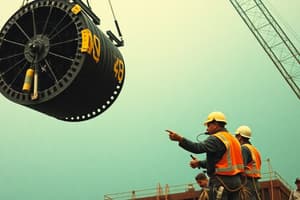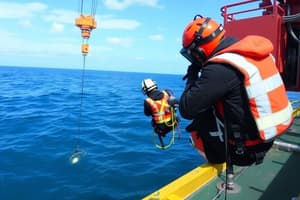Podcast
Questions and Answers
During the subsea spool tie-in operations, what primary factor contributed to the crane hook striking the diver's helmet?
During the subsea spool tie-in operations, what primary factor contributed to the crane hook striking the diver's helmet?
- The diver failed to follow the correct procedures for disconnecting the rigging.
- The diving supervisor was not properly trained to supervise the dive operation.
- Inadequate length of the crane pennant/stinger, coupled with poor visibility, led to insufficient distance between the divers and the crane hook. (correct)
- The crane operator intentionally lowered the hook too quickly.
What action taken after the incident demonstrated a commitment to safety and continuous improvement?
What action taken after the incident demonstrated a commitment to safety and continuous improvement?
- The immediate replacement of the damaged diving helmet with a newer model.
- The implementation of stricter penalties for crane operators who make errors.
- Updating project procedures to specify minimum pennant lengths and conducting pre-operation inspections of rigging and lifting equipment. (correct)
- The decision to discontinue subsea spool tie-in operations indefinitely.
In environments with poor visibility, what alternative methods should be considered to better track the position of critical equipment like the crane hook?
In environments with poor visibility, what alternative methods should be considered to better track the position of critical equipment like the crane hook?
- Use longer crane pennants/stingers without any additional monitoring.
- Rely solely on the experience and judgment of the crane operator.
- Increase the speed of the subsea operations to reduce the time spent in low visibility conditions.
- Additional locating beacons, underwater cameras, or sonar. (correct)
What assumption by the Diving Supervisor directly contributed to the incident?
What assumption by the Diving Supervisor directly contributed to the incident?
Besides equipment and procedures, what key element should be reinforced to ensure all parties are fully aware of the equipment's location at all times?
Besides equipment and procedures, what key element should be reinforced to ensure all parties are fully aware of the equipment's location at all times?
Flashcards
Subsea Crane Hook Incident
Subsea Crane Hook Incident
During subsea operations, a crane hook unexpectedly struck a diver's helmet due to a misjudgment of the hook's position.
Causes of the Incident
Causes of the Incident
Inadequate crane pennant length and poor visibility led to the crane hook slipping off the PHF and striking the diver's helmet.
Preventative Actions
Preventative Actions
Maintain safe distance, enhance visibility, reinforce communications, and minimize assumptions regarding equipment position during subsea operations.
Enhanced Visibility Aids
Enhanced Visibility Aids
Signup and view all the flashcards
Reinforced Communication
Reinforced Communication
Signup and view all the flashcards
Study Notes
- During subsea spool tie-in operations, a crane hook unexpectedly struck a diver's helmet.
What happened?
- Divers were working on the seabed in poor visibility during subsea spool tie-in operations.
- After landing the pipe handling frame (PHF) on the seabed, the Diving Supervisor instructed the crane operator to lower the crane hook to the seabed to allow the diver to disconnect rigging from crane.
- The crane operator reported that there was 'no weight' on the crane wire,
- The Diving Supervisor assumed the hook had reached the seabed and instructed the diver to proceed with disconnecting the PHF from the crane.
- The crane hook unexpectedly struck the diver's helmet.
- The diver reported that they were unharmed and well, and immediately returned to the dive bell.
- The dive was aborted.
- Upon inspection, the diver's reclaim helmet was damaged beyond repair, including the side block.
- The integrity of the helmet was maintained and the diver was unharmed.
What went right?
- Diver 2 promptly assisted Diver 1, ensuring that no injuries were sustained, and both divers immediately returned to the bell safely.
- Both divers and the crane block had locating beacons fixed to them enabling accurate tracking.
- All procedures, lifting plans, and Job Hazard Analysis (JHA's) were followed throughout the operation.
- Protective equipment worked effectively, the diver was uninjured because the impact was absorbed by the helmet.
What went wrong?
- When the crane hook was lowered for PHF rigging disconnection, it came to rest on the top beam of the PHF.
- This resulted in a 'no weight' reading, leading the crane operator to assume the hook had reached the seabed.
- As the diver approached the disconnection point, the hook slipped off the beam and struck the side of the diver's helmet.
What was the cause?
- Inadequate length of crane pennant/stinger did not provide sufficient distance between the divers and the crane hook.
- Poor visibility hindered the ability to accurately observe the position of the crane hook.
Lessons and actions
- Ensure adequate distance between divers and the crane hook:
- The length of the crane pennant/stinger should be sufficient to maintain a safe distance between the divers and the crane hook during subsea operations.
- Minimise the risk of accidental contact with the hook, particularly in limited visibility conditions.
- Enhanced visibility aids and monitoring:
- Alternative methods such as additional locating beacons, underwater cameras, or sonar should be considered to better track the position of critical equipment.
- Improved monitoring can help prevent misjudgements about the location of the crane hook.
- Reinforce communication and challenge assumptions.
- Assumptions regarding equipment position are minimised.
- Clear communication and confirmation procedures between the dive supervisor, crane operator, and divers should be reinforced.
- Ensure all parties are fully aware of the equipment's location at all times.
- Project procedures are updated to specify minimum pendant lengths for different operations.
- Conduct pre-operation inspections of all rigging and lifting equipment, including crane hooks and pennants, to ensure they meet safety standards and are appropriate for the operation.
- Update the Job Hazard Analysis (JHA) to incorporate lessons learned from this incident, particularly regarding safe distances, visibility, and communication requirements for subsea lifting operations.
Studying That Suits You
Use AI to generate personalized quizzes and flashcards to suit your learning preferences.




